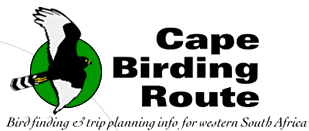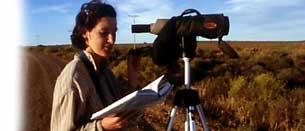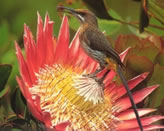Berg
River Estuary, Velddrif
The
estuary and floodplain cover a vast area, extending 40 km
inland along one of the Cape’s biggest rivers. This area
encompasses a wide diversity of habitats, including sandy
beaches, mudflats, reedbeds, riverine channels, strandveld
and floodplain, and it is famously rich in birdlife. The floodplain
itself, which is very seasonal and difficult to access, holds
few birds that cannot be seen nearer the mouth. Rather, it
is the mudflats and saltpans that provide the most rewarding
birding, and have proven excellent for rarities (see box,
p.50). Ornithologists at the Percy FitzPatrick Institute (see
p.57) have studied this region intensively and have shown
that these mudflats support the highest density of waders
along the entire east Atlantic seaboard.
After
140 rather monotonous kilometres from Cape Town, the R27 coastal
road spans the Berg River and enters the town of Velddrif,
which sprawls along its northern bank. Just before the road
crosses the river (1 on map above), the Cerebos salt works
(2) lies to the left. The evaporation pans of this conveniently
non-tidal locality are particularly good for Chestnut-banded
Plover, and roosting waders that flee the mudflats at
high tide. Another advantage here is that the birds are often
closely approachable from the comfort of your vehicle; ask
permission at the office to drive around (but don’t try
this in winter when the rains make the roads extremely slippery).
The
pans closest to the offices (2 on map) are the most reliable
for Chestnut-banded Plover, which may be seen here
in fair numbers. The bulk of South Africa’s population
of this localized species occurs on the saline pans of the
West Coast. Kittlitz’s Plover is also common here,
and often nests on the edges of the roads that skirt the pans.
During summer, large numbers of waders feed along the pan
margins; the most common species include Little Stint,
Ruff, Ringed Plover and Curlew Sandpiper.
Other birds here, especially in the vicinity of 3, include
Black-necked Grebe, Greater and Lesser Flamingo,
Cape Teal and Caspian Tern. It is also worth
scanning the pans on the east side of the R27 at 4, which
hold a selection of small waders, Black-winged Stilt,
Avocet and South African Shelduck. Red-necked
Phalarope is recorded here infrequently (but beware of
distant Ruff that often feed by spinning in circles
in an alarmingly phalarope-like manner!). Also look out for
Thick-billed Lark and Capped Wheatear in the
salt works.
To
reach the back entrance of the salt works, take the R399 Vredenburg
road and follow the Flaminkvlei right turn (5). This road
initially passes some farmland: Thick-billed Lark and
Stonechat occur here, and Jackal Buzzard is
often seen in this vicinity (but note that the juveniles can
resemble Steppe Buzzard). Greater Flamingo is
often observed in this part of the salt works. Just beyond
the buildings, a sandy track leads leftwards towards the coast
and the strandveld along here (6) holds Cape Long-billed
Lark.
 |
 |
|
Exciting
Rarities, including Little Blue Heron and Lesser Yellowlegs,
have been viewed from the Riviera
mudflat bird
hide at Velddrif on the Berg River estuary
(7 on the map)
|
White
Pelicans at the Berg River Estuary |
The
Riviera mudflat is perhaps the most famous of the Velddrif
birding localities, and a number of rarities have been seen
here — most famously the only African record of the American
Little Blue Heron. The bird hide is situated at 7 (ask
at the adjacent filling station or restaurant for the key).
As always, it is important to get the tide right: the best
viewing begins about 1.5 hours after the ‘High tide in
Table Bay’ as listed in Cape Town newspapers. A diverse
selection of waterbirds may be observed from here, including
White Pelican, African Spoonbill, Greater
and Lesser Flamingo, Purple Heron, Little
Egret, and a wide selection of terns including Caspian
and Little Terns. The mudflats are excellent in summer
for migrant waders, and the selection of species is very similar
to that at the Geelbek mudflat hide (refer to p.47). Confiding
Levaillant’s Cisticola call from the nearby sedges.
The
De Plaat mudflat (8) holds similar birds (and Curlew
and Bar-tailed Godwit are easier to see here), although
it is not as easy to approach them closely. De Plaat can be
reached by taking the R399 and turning right into Vrede Road
(opposite the ‘Spreewal Kafee’ building). Turn right
again, follow this road to its end, and walk down past the
eucalyptus trees to the wooden jetty. Again, be sure to visit
on the correct tide: the best viewing begins about 3.5 hours
after the ‘High tide in Table Bay’.
To
reach an area of riverine channels and reedbeds (9 on map),
where a variety of herons, warblers and other waterbirds may
be found, take the main road east past the bird hide, and
turn right along the road signposted ‘Bokkoms Industry’
(referring to a West Coast speciality: malodorous dried fish)
and continue to the banks of the river. Wooded residential
areas of Velddrif, such as those in this vicinity, usually
provide Red-faced Mousebird and Acacia Pied Barbet.
At
the harbour on the river mouth in Laaiplek (0), a selection
of cormorants, gulls (a good site for the scarce Grey-headed
Gull) and terns roost. The latter are harried in summer
by Arctic Skua just offshore.
A
pair of Spotted Eagle Owl is resident at the copse
of eucalyptus and wattle trees at A, along the Hopefield road.
An excellent area for strandveld birds may be reached along
the R27, 10 km south of Velddrif, opposite the turnoff to
‘St Helena / Stompneus’. Continue along the unsurfaced
road to the east for 1 km, and bird the strandveld near the
crest of the hill. Birds present here include Southern
Black Korhaan (p.57*), White-backed Mousebird,
Karoo Lark, Southern Grey Tit, Cape Penduline
Tit, Layard’s Titbabbler, Long-billed Crombec,
Bar-throated Apalis and White-throated Canary.
Cape Long-billed Lark (p.13) is occasionally seen near
the R27 roadside, just to the south of here, although beware
of confusion with the much more common Thick-billed Lark.
The
ephemeral Rocher Pan, a large waterbody protected in a nature
reserve 24 km north of Velddrif, may be reached via the hamlet
of Dwarskersbos. It often supports an interesting selection
of waterbirds, and is flanked by very productive strandveld
vege-tation and a lonely coastline. A desolate beach stretches
towards the seemingly limitless horizon, populated only by
the occasional pair of African
Black Oystercatchers.
|


